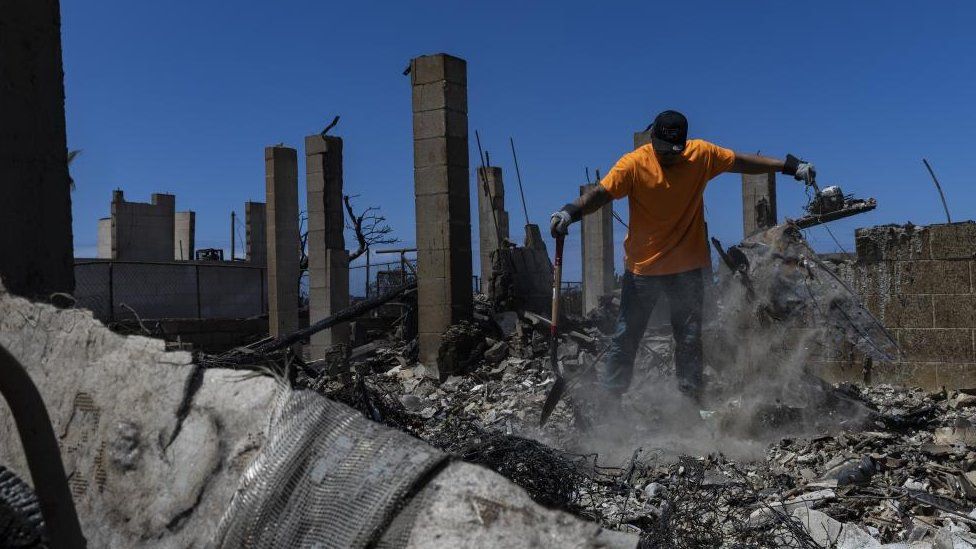Nearly a week after a devastating wildfire swept across Maui, the true death toll remains unclear.
Families of around 1,300 missing people are waiting anxiously as cadaver dogs scour the blackened disaster zone.
The confirmed death toll of nearly 100 people is expected to rise steadily. Hawaii’s Governor Josh Green said on Monday that it could take as long as 10 days to reach an accurate figure, and investigators could find “10 to 20 people per day probably until they finish”.
As of 15 August, only three of the dead had been positively identified, according to Adam Weintraub, the communications director of the Hawaii Emergency Management Agency.
Victim identification specialists told the BBC that putting names to the rest of those who perished in Maui could take months or even years.
Both finding and identifying victims will be arduous given the magnitude of the destruction – which emergency workers have described as “extremely hazardous” – and the condition that many of the remains are likely to be found in.
This video can not be played
To play this video you need to enable JavaScript in your browser.
On Monday, Maui County Police Chief John Pelletier described the grim reality of the situation on the ground, telling reporters that “it’s not just ash on your clothing when you take it off. It’s our loved ones”.
“The complicated part is the collecting,” said Daniele Podini, an associate professor of forensic molecular biology at George Washington University.
“Finding the right samples, identifying relatives, creating a database for all the relatives of the missing and then comparing the results from samples to that database… It’s a combination of everything.”
Chris Milroy, a professor of pathology and laboratory medicine at the University of Ottawa, said that in Hawaii’s case, many of these scientific methods may be complicated by destruction in the area.
“[Because] there has been a fire and disruption of civil services, you may not be able to get a hold of dental records. Some of the records may also have been destroyed in the fire,” said Mr Milroy, who also worked on forensic investigations with police in the UK and with war crimes investigators in the Balkans. “So that method may be out for a lot of people.”
The high temperatures may have destroyed some victims’ fingerprints, he added. The same may be the case for any documentation that would allow investigators to match a person with a medical device – such as a hip replacement or pacemaker – or for items from which DNA samples can be taken.
- ‘Raised to hate tourists’ – Fires fan tensions on Maui
- When the fires hit, Maui’s warning sirens were deathly silent
“The principal thing that you’re probably looking at is DNA,” he said. “But you also need people you can compare it to. But even then, you could also have something like brothers who died. You’ll be able to say that they’re related, but you won’t be able to say which brother is which, unless you have other circumstantial evidence.”
Visual identification by relatives is considered unreliable, as is the discovery of personal belongings such as bags or wallets near sets of human remains.
“There’s an issue of commingling and remains that may be fragmented,” Mr Milroy said. “And since most of the people [who have died] are likely to be damaged by fire, what may happen is that a relative may go in and be so upset by the process that they say yes, and then it’s not true. That’s why scientific methods are preferred”.
This video can not be played
To play this video you need to enable JavaScript in your browser.
Specially trained cadaver dogs are playing a key part in the search. The dogs are able to move through debris without causing further destruction and can use their keen sense of smell to detect human remains – even those that have been burnt to ashes that would be difficult to detect with the naked eye.
While 20 additional cadaver dogs from the Federal Emergency Management Agency (Fema) have been deployed in the area, the amount of time they can work each day is hindered by high temperatures and a need for rest periods.
While the challenges in Hawaii are acute, long delays in victim identification aren’t unusual in the aftermath of fires and other catastrophic disasters.
After a fire gutted the 24-storey Grenfell Tower in London in 2017, for example, it took about five months for investigations to conclusively identify all 72 victims in the residential building. Once visible remains were removed from the scene, investigators had to use small towels and mesh sieves to find smaller and harder-to-identify pieces of human remains.

In the US, remains retrieved from the wreckage of the World Trade Center towers after the 9/11 attacks in 2001 are still being identified. The remains of about 40% of those killed are still unidentified.
Mike Marciano, a forensic scientist who teaches at Syracuse University in New York, said that the investigation in Hawaii will probably benefit from federal and out-of-state resources.
This could potentially include help from the US armed forces’ DNA Identification Laboratory, which is normally tasked with identifying the remains of lost servicemembers dating back as far as the Second World War. The lab has an $80m (£62.8m) facility at Joint Base Pearl Harbor-Hickam on the nearby island of Oahu.
Even then, he said, the process will be a slow one.
“This is going to be a process that’s going to last much longer than weeks,” he said. “I would say months, but it all depends on resources”.
Related Topics
- Hawaii wildfires 2023
- Hawaii
- United States
